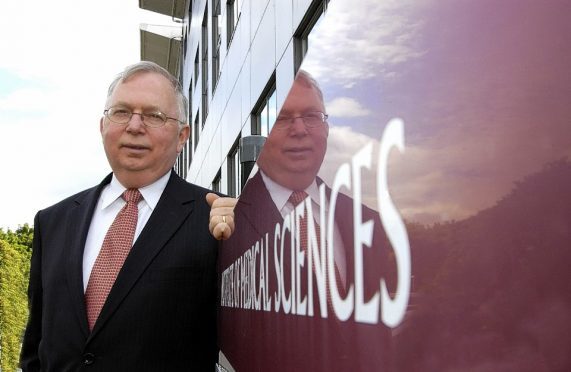The brains behind a potential treatment for Alzheimer’s disease has hailed the support of Aberdeen University as his firm’s drug completed a significant clinical trial.
Professor Claude Wischik, chairman of TauRx Therapeutics, said the Granite city university was “better than Cambridge” for the support the company has received developing its drug, LMTX.
Aberdeen has provided the research base for LMTX since the academic moved his research team – along with the intellectual property behind the drug – from Cambridge to Aberdeen in 1997. In 2002, Mr Wischik, 67, co-founded spin-out TauRx along with late Singaporean investor, Dr KM Seng.
Since then, the Singapore headquartered TauRx has raised $500million (£380million) from investors around the globe to fund a series of clinical trials of its drug, the latest of which showed mixed results – but which has been shown to delay brain deterioration caused by the devastating disease in some patients.
Serge Gauthier, chair of TauRx’s scientific advisory board, presented the results of the phase III trial at the Alzheimer’s Association International Conference in Toronto, Canada this week.
He said: “In a field that has been plagued by consistent failures of novel drug candidates in late-stage clinical trials and where there has been no practical therapeutic advance for over a decade, I am excited about the promise of LMTX as a potential new treatment option for these patients.”
Critics have dismissed the recent 891-patient study as “failed” because did not meet its main goals. Only 15% of those in the trial responded to the treatment – all of whom showed early stages of Alzheimer’s and who were not taking other drugs for the disease.
Mr Wischik, who first observed abnormal fibres of tau protein giving rise to “tangles” in the brains of Alzheimer’s patients, believes TauRx is still on track to launch a first line treatment against the disease.
“I am disappointed it didn’t help the 85% because the whole object here is to help people,” he said.
But the impact on those that did respond to the drug reflect similar findings in another trial the firm is conducting, the results of which will be released later.
“These are very early days in terms of the clinical field, learning how to use a drug like this,” he said.
“If these results are accepted by the regulatory authorities, this will for sure change the nature of clinical practice.”
The current time line for getting the drug to market is “imponderable” as the firm presses on with regulatory hurdles, he added.
But he praised the support of academic colleagues at the University of Aberdeen where the drug’s progress is being led.
He said: “We are deeply embedded in the University of Aberdeen and we are deeply grateful to the university for having supported us throughout.
“It is in fact in many ways a better environment than Cambridge. It is more collegiate.”
Professor Phil Hannaford, University of Aberdeen vice-principal and head of the college of life sciences and medicine, said: “Knowing how devastating Alzheimer’s disease can be for patients, their families and carers, it is especially pleasing to note this pioneering research from the University of Aberdeen.
“The work involves researchers from a number of disciplines across the university, collaborating with scientists and clinicians around the world.
“It is an excellent example of the university’s world-class life science research”.










